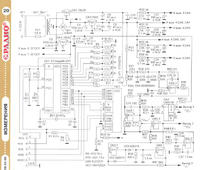Eng.Fahd
Junior Member level 3

- Joined
- Aug 17, 2011
- Messages
- 25
- Helped
- 4
- Reputation
- 8
- Reaction score
- 4
- Trophy points
- 1,283
- Activity points
- 1,467
I want to generate a sinewave with variable frequency (from Hz to 1 MHz) using microcontroller.... First I used DDS method and it worked but I couldn't reach to 1 MHz ... so this method didn't work .... Then I found IC's like max038 which generate sinewave but I don't want to use them ....
I think I can use microcontroller to generate square wave and then I will convert it to sine wave (I think using a filter)... so I want your help in this step ....
because for 1 MHz I don't know if I can convert this signal using a filter ....
And should I use many filters for the variable values of frequency of sine wave....
Any help, or new ideas or suggestion ...
Thanks.....
I think I can use microcontroller to generate square wave and then I will convert it to sine wave (I think using a filter)... so I want your help in this step ....
because for 1 MHz I don't know if I can convert this signal using a filter ....
And should I use many filters for the variable values of frequency of sine wave....
Any help, or new ideas or suggestion ...
Thanks.....




